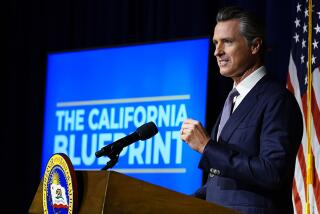Wilson Appeals for School Cuts in Budget Stalemate : Spending: State issues IOUs for first time since the Depression. No thaw seen in cold war as Democrats tell governor to abandon hope for his education reductions.
SACRAMENTO — With the state government out of cash and issuing IOUs to its creditors, Gov. Pete Wilson called on Assembly Democrats on Wednesday to reconsider their rejection of his proposal to take as much as $2 billion from the public schools.
Wilson said the education cut was needed to help balance his proposed spending plan, which he presented for the first time Wednesday after weeks of ignoring Democrats who complained that he was hiding the true magnitude of service cuts that he contemplated.
Without the reduction in education spending, Wilson said, the state’s health and social service programs, the higher education system and prisons would have to endure cuts so “repugnant” that their consideration would paralyze the Legislature and leave the state “hopelessly adrift.”
But Democratic leaders said Wilson should accept the will of the Assembly and abandon hope of making the cut he wants in education spending, which would include tripling community college fees and blocking 110,000 4-year-olds from entering kindergarten on schedule in the fall.
“It’s not going to happen,” said Democratic Assemblyman John Vasconcellos of Santa Clara, chairman of the Ways and Means Committee. “He’s six months late and several billion dollars short.”
With no visible prospects for a thaw in the cold war that has developed between Wilson and the Legislature, the stalemate has forced the state to begin the new fiscal year without a budget. As a result, Controller Gray Davis has issued IOUs, known as registered warrants, instead of checks to about 12,000 people awaiting refunds from state income tax returns.
Although this is the fifth consecutive time the state has failed to meet the June 30 budget deadline, this year is different because the government, after running up a $3.8-billion deficit in the year that ended Tuesday, is out of cash.
Until a budget is in place, the state’s financial officers cannot borrow from private investors to meet the government’s cash flow needs, as they do routinely in normal years.
They can issue the registered warrants, which are redeemed as cash becomes available, only for expenses incurred before June 30, for constitutional obligations and for payments ordered by the court. Other state functions cannot be funded at all until a budget is enacted that authorizes the appropriations.
The state’s fiscal crisis, Wilson said, is a “tragedy for the people of California.” The Republican chief executive laid the blame squarely on the Democrats who control the Assembly.
“This didn’t have to happen,” Wilson told reporters in his Capitol office. “The Assembly Democrats demonstrated just how out of touch they are.”
Wilson’s education proposal was the cornerstone of his budget strategy because school funding is the single largest item of state spending and is controlled by Proposition 98, the constitutional amendment voters passed in 1988.
Although the measure protects school funding, it has provisions that give the state flexibility during bad economic times. Under one of those provisions, the Legislature could have acted by midnight Tuesday to take back $1.1 billion the schools had already received. The same cut could have been applied to the new fiscal year, producing a combined reduction of up to $2 billion from the $25 billion that schools were set to receive from state and local government. This is what Wilson proposed.
Senate Democrats late Tuesday voted with Republicans for the legislation to cut at least $1 billion and as much as $2 billion from the schools. The exact amount was to be determined later in negotiations with the governor.
But in the Assembly, as the midnight deadline approached, Democrats said they did not believe Wilson would soften his demand for the full $2-billion cut. Joined by 10 of the 33 Assembly Republicans, Democrats rejected the proposal.
Now, because the books have been closed on the 1991-92 fiscal year, the schools are entitled automatically to all of the money in question unless the Legislature votes to suspend Proposition 98, which would require the consent of two-thirds of the members of the Senate and Assembly.
State Schools Supt. Bill Honig said Wednesday he doubted that Proposition 98 would be set aside. But he said the schools still might accept $700 million less from the state than they are entitled to--a move that would have the effect of a one-year loan from the schools to the state’s general fund.
“We can try to work something out,” Honig said. “Obviously this is a unique situation.”
But Wilson seemed to be in no mood for working things out Wednesday afternoon. After making public his spending plan--which is $2 billion out of balance without the schools cut--he said it was up to Assembly Democrats to solve the problem.
“The Legislature failed to act last night and so now they must outline where they intend to make the additional cuts needed to produce a balanced budget,” the governor said.
Wilson offered no explanation of what was contained in his 510-page proposal, other than to say it was consistent with his earlier call for 15% cuts in health and welfare programs, 11% in higher education, 3% in prisons and up to 30% in other state services.
Legislative aides who studied the proposal said it called for eliminating almost entirely parole supervision for nonviolent offenders, abolished state funding for the Arts Council and included a $200-million reduction to be distributed later among programs other than the schools, health and welfare, University of California and the prisons.
The budget also included Wilson’s earlier call for cuts of up to 25% in welfare grants to poor mothers with children and the elimination of dental care and other health services for the poor. The plan calls for fee increases of 40% for CSU students and 24% for students at the University of California.
Wilson rejected a Democratic plan that meets his demand for no taxes and no deficit financing but balances the budget with the help of a number of one-time adjustments, including $900 million saved by delaying for one fiscal year payment on a month’s worth of Medi-Cal bills. That plan would cut school funding by $605 million.
The governor said this was “a little like a businessman saying he’s going to collect his accounts receivable for all his customers, but not pay his debts until next year. Of course, neither he nor you can get away with that in real life.
“But the Assembly Democrats would--if we let them--just push this year’s debts into next year.”
Assembly Speaker Willie Brown (D-San Francisco) defended all of the one-time measures in his budget. Brown said they were meant to pay off the $3.8-billion deficit, which he said is a one-time problem. In the rest of the budget, he said, ongoing expenditures are balanced by permanent revenues.
The accounting shift would not be needed, Brown said, if Wilson would back away from his opposition to a balanced, two-year spending plan that stretches out repayment of the deficit.
“I have no idea why there is an objection to an intelligent process for doing two-year funding of a program for the operation of the state of California,” Brown said. “It’s an intelligent thing to do.”
Times staff writer Carl Ingram contributed to this story.
RELATED STORIES: A3
Road to a Fiscal Dead End
Here is a look at the events that have led to the budget impasse:
JAN. 9: Gov. Pete Wilson proposes a no-new-taxes $60.2-billion budget for 1992-93, conceding later that it is $5.7 billion out of balance.
MARCH 30: Assembly Democrats unveil their budget plan, also with no new taxes and with even deeper cuts in state services than Wilson proposed. The governor rejects the plan as unworkable but offers no alternative to balance the budget.
MAY 20: Wilson updates the state’s financial condition, announcing that expenditures will run nearly $11 billion beyond revenues over two years. Breaking with tradition, governor offers no plan to bring the budget back into balance.
JUNE 19: Wilson proposes another budget outline that aims to erase the spending gap with deep reductions, $2.1 billion in education alone, as well as cuts in welfare and other services, but offers no details on specific programs to be hit.
JUNE 23: Democratic lawmakers unveil a new outline for balancing the budget by sparing education but cutting all other spending, raising taxes, shifting obligations to local governments and stretching deficit repayment over two years. Wilson quickly rejects the plan and Republicans shoot it down in the Senate.
JUNE 29: Democratic leaders back off call for taxes and deficit rollovers. They offer a plan that, to replace new taxes, would cut state programs by $2.8 billion--half of that from health and welfare--and take $1.4 billion from local governments. The plan also includes about $3 billion in one-time economies, which Wilson aides say would be irresponsible.
JUNE 30: Senate passes but Assembly Democrats block passage of Wilson plan to cut $2 billion from schools, loan them back $1 billion and then decide later when the schools must repay the loan. Assembly Republicans block passage of Democratic budget plan balanced with help of schools cut of $600 million.
JULY 1: Deadlock forces the state to enter the new fiscal year without a budget. Out of cash, the state for the first time since the Great Depression issues IOUs to pay bills left over from the previous fiscal year. Most ongoing functions of state government cannot be funded at all until a budget passes with authorization for the appropriations.
More to Read
Get the L.A. Times Politics newsletter
Deeply reported insights into legislation, politics and policy from Sacramento, Washington and beyond. In your inbox three times per week.
You may occasionally receive promotional content from the Los Angeles Times.










